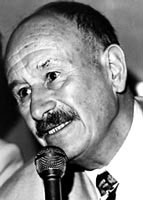Brief, and that’s the point
Whatever the creatives think, briefs weren’t invented to stifle their genius, says David Bernstein.

shall be interested to see the new Cobra beer bottle – and especially its label. Consultancy Williams Murray Hamm has been given a difficult brief (DW 29 May) ‘to maintain Cobra’s “quirky” identity, while progressing the design to appeal to a broader audience’.
This is one of those classic ‘however’ briefs – for example, ‘while maintaining our traditional base, we must, however, seek to broaden the brand’s appeal’. Niche goes mass. Here’s Richard Murray: ‘The Cobra label looks like it was made by Indian printers and that’s an important part of its charm. We want to maximise that point-of-difference, but execute it in a way that enables it to succeed beyond where it currently is.’
Creatives notoriously regard a brief as either a necessary evil or a starting point, probably important, but largely dispensable. The enlightened see it as an integral part of the creative process and reject the view that a brief restricts creativity. In a sense, of course, it does. A good brief marks out the course, ensures that the solution is relevant. But to channel a creative impulse is not to stifle it. It is important not to equate limitation with handicap.
The creative process in marketing communications is one of narrowing down. The brief itself is a distillation of the strategy which, in turn, was a choice among options. The creative task is to extract the essence of the brief – the proposition – and transmute it into an idea.
Discipline isn’t just an administrative necessity, but also a creative necessity. Of course, it’s a limitation – as the frame is to the painter, the sonnet form to the poet, the two-dimensional screen to the film-maker. But the artist’s job is to exploit the limitations, not surrender to them. The really great examples of poster art are triumphs of imagination set free by limitation. Milton Glaser caught the importance of the brief and the creative task when he said ‘the answer is in the
question’. Interrogate the brief and it will release its creative secret.
A brief must limit itself to essential information and, if necessary, confine lesser facts to an appendix. Relevance is the first test, then degrees of relevance – and difficult choices must be made if a focused message is to result. Too often the brief allows itself a freedom denied the creative and it’s the latter who has to impose a focus. Single-mindedness must start with the brief. It’s not the creative’s role to settle arguments unresolved at a client meeting in committee. ‘Promise, large promise is the soul of an advertisement,’ said Doctor Johnson. Promise – singular. When committee meets promise, the result is compromise.
Checklists help avoid this. They ensure that the key points are covered. A well-known format in advertising is benefit/reason-why/tone of voice – fundamentals that force the writer of the brief to consider the brand’s promise, how it can be justified and the style of the expression. Other aspects need to be included such as the strategic business reason for the exercise, the relationship with previous communication and any executional guidelines. But predominant is the purpose of the communication expressed as a target response. In other words, what do we want the recipient of the message to think, believe, feel, do as a result?
Answering these questions ensures that the brief is both action-oriented and consumer-oriented, that it sees and treats the recipient as a sentient human being with a relationship with the brand that is to be reinforced or modified. This ensures also that the brief is written in consumer language rather than adspeak.
Occasionally, the brief itself is creative, providing an insight, an imaginative penetration that will drive the creative approach. One of the best clients I knew saw his brands in a distinctive way, was able to communicate that and inspire those who worked on them.
I should imagine Vittorio Radice, Marks & Spencer’s home division executive director, is that sort of client. He was describing the design challenge presented by M&S’s Lifestore home furnishing concept (DW 29 May): ‘It’s all about getting customers to consider time spent in the home, not space; and rituals, not furnishings. We need to get them thinking about what they need to rest and relax, be it a cushion, a candle or a sofa.’
I, for one, would be happier tackling that brief than the one for Cobra.
-
Post a comment




